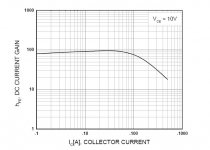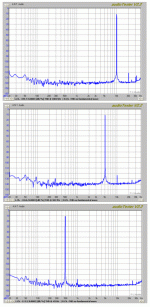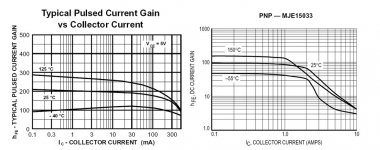Bonsai said:Bob (Cordell),
have you had any thoughts about re-doing your original distortion analyzer but with modern components?
Might make an interesting collaborative project on this site. There are a lot of newer, better components now so I am wondering if th e whole thing could be simplifed somewhat - single PCB, maybe a ucontroller to manage the user interface and automate measurements (or, maybe just use a PC and do it via USB).
PC based sound cards are good, but I think there is space for a top notch DIY analyzer that does'nt cost $40k (we just got a quote here on an AP system)
What do you think? I reckon there will be many willing volunteers.
I've actually thought about this (and been asked) many times. There are, of course degrees of improvement. The three most common directions are a) to improve performance; b) to make building it more manageable and less expensive; c) to make its use more convenient.
For improved performance, modern op amps could probably help a lot, both with distortion residual and noise. The original unit employs 5534's. They perform surprizingly well, but I am sure they can be improved upon in this application. Use of the low-distortion National op amps would be tempting. I don't think I would change the basic circuit topology very much.
The single biggest expense and PIA in the old analyzer was the multi-gang rotary switches. If available, they are surely expensive and involve a lot of rats-nest wiring. At minimum, I would go for relay trees instead, mounted on the board along with the frequency-control R's and C's. Whether or not to go for continuous tuning capability would be a good question, but I would not rule it out.
Putting it on one PWB would certainly make sense; the old one was on three smaller single-sided PWBs. I'm sure not all of them got built, but we actually sold about 220 sets of the PWBs.
For convenience, one would incorporate digital readouts for both input level and distortion value. Going further, one might incorporate a PIC microcontroller and have a multi-line LCD readout.
The idea of hitching it to a PC, perhaps by USB, is also very appealing; then all kinds of nice user interface things become available (and it is starting to look like an Audio Precision AP1). I would make hitching it to a PC optional, so that the analyzer could still function stand-alone.
One could also be very tempted to put a 192/24 ADC on it to digitize the residual for processing in the PC.
Cheers,
Bob
scott wurcer said:Keep checking the catalog we have some new 36V parts coming out of CA. Audio folks are in luck it's no surprise the instrument guys are chasing the same numbers.
Yes, I'll do that. There's already the ADA4898-1, which looks very good. However, my sound card contains all dual op-amps, so I hope the dual version of the ADA4898 comes soon.
Thanks,
Edmond.
John,
Here's a quick example from a MOTO datasheet. I don't consider the slight monotonic rise in beta interesting YMMV.
On another point the axes are mislabeled on several plots (1000A indeed). This is indicative of a sloppyness that is sweeping our industry.
Here's a quick example from a MOTO datasheet. I don't consider the slight monotonic rise in beta interesting YMMV.
On another point the axes are mislabeled on several plots (1000A indeed). This is indicative of a sloppyness that is sweeping our industry.
Attachments
Hi John,
I checked my setup for its capabilities for measuring 5 kHz THD (THD-5). The setup consists of the THD analyzer I designed a long time ago (it uses 5534 op amps, mostly) where the residual distortion output is fed to an HP3580A analog spectrum analyzer that can go up to 50 kHz. This analyzer is pretty good at getting the noise out by selecting a very narrow bandwidth, but that is at the expense of long sweep times. I think these measurements were done with a 30Hz bandwidth and 100 seconds per division sweep time. The distortion analyzer was just connected back-to-back, with 1 V rms going across.
The meter on the analyzer read 0.0006%, or about -105 dB (THD+N) in a 50 KHz bandwidth (my analyzer always LFP’s the residual signal at a frequency equal to 10X the original).
The second harmonic was most prominent, and it read -106 dB. I think this is distortion from the oscillator leveling circuit. Third read -124 dB, and everything else was in the grass, which was at 130 dB. The readings took about 17 minutes to get, due to the slow sweep time – one of the disadvantages of the old-fashioned analog approach.
My analyzer would probably profit from more up-to-date op amps to reduce the noise and residual distortion, and possibly some tweaking of the oscillator to get the second harmonic down further.
Largely because of my spectrum analyzer bandwidth limitation and my desire to conduct distortion measurements at higher frequencies, my preferred method these days is to do CCIF 19+20 kHz tests. This is also easy to compare to the same kind of tests done in Stereophile. The spectrum analyzer specified dynamic range of only 80 dB (90 dB on a good day) is a limiting factor here, so I must do a subtraction. I do it in the analog domain using my Distortion Magnifier, which magnifies distortion by 20 dB or 40 dB before it is applied to the spectrum analyzer (it just subtracts a scaled version of the generator signal from the output of the DUT, with careful gain and phase equalization). This allows me to see down to about -120 dB on the CCIF test. One thing that is nice about the CCIF test is that the two oscillators themselves do not have to be extraordinarily low in distortion; only the summer has to be really good.
Cheers,
Bob
I checked my setup for its capabilities for measuring 5 kHz THD (THD-5). The setup consists of the THD analyzer I designed a long time ago (it uses 5534 op amps, mostly) where the residual distortion output is fed to an HP3580A analog spectrum analyzer that can go up to 50 kHz. This analyzer is pretty good at getting the noise out by selecting a very narrow bandwidth, but that is at the expense of long sweep times. I think these measurements were done with a 30Hz bandwidth and 100 seconds per division sweep time. The distortion analyzer was just connected back-to-back, with 1 V rms going across.
The meter on the analyzer read 0.0006%, or about -105 dB (THD+N) in a 50 KHz bandwidth (my analyzer always LFP’s the residual signal at a frequency equal to 10X the original).
The second harmonic was most prominent, and it read -106 dB. I think this is distortion from the oscillator leveling circuit. Third read -124 dB, and everything else was in the grass, which was at 130 dB. The readings took about 17 minutes to get, due to the slow sweep time – one of the disadvantages of the old-fashioned analog approach.
My analyzer would probably profit from more up-to-date op amps to reduce the noise and residual distortion, and possibly some tweaking of the oscillator to get the second harmonic down further.
Largely because of my spectrum analyzer bandwidth limitation and my desire to conduct distortion measurements at higher frequencies, my preferred method these days is to do CCIF 19+20 kHz tests. This is also easy to compare to the same kind of tests done in Stereophile. The spectrum analyzer specified dynamic range of only 80 dB (90 dB on a good day) is a limiting factor here, so I must do a subtraction. I do it in the analog domain using my Distortion Magnifier, which magnifies distortion by 20 dB or 40 dB before it is applied to the spectrum analyzer (it just subtracts a scaled version of the generator signal from the output of the DUT, with careful gain and phase equalization). This allows me to see down to about -120 dB on the CCIF test. One thing that is nice about the CCIF test is that the two oscillators themselves do not have to be extraordinarily low in distortion; only the summer has to be really good.
Cheers,
Bob
Scott, compromise is not MY middle name. Isn't that a PNP transistor? If so, well DUH! The IC NPN example that I got from Raytheon looks like a mountain range.
However, not all is lost. Even if you used the Gummel Poon model, you would see big problems, but apparently the newer model, VBIC, shows more linearity over the center range of the device.
However, not all is lost. Even if you used the Gummel Poon model, you would see big problems, but apparently the newer model, VBIC, shows more linearity over the center range of the device.
I’m confused about which sound card would be better for PC based sound analyzing: a USB one like EMU 0404, or an internal one with better spec like Asus Xonar Essence?
Also, any recommendation for a good PC Scope?
Also, any recommendation for a good PC Scope?
phil:
what did you do for switching in your version of bob's analyzer?
mlloyd1
what did you do for switching in your version of bob's analyzer?
mlloyd1
PH104 said:Bonsai -- I am rebuilding my Cordell THD analyzer right now. One upgrade I want to try is to use the AD797 in place of many of the 5534's Bob Cordell originally specified. I would certainly be one of those volunteers to try some upgrades. I am open to any suggestions for improvements and willing to post my results.
Phil
Please everyone, learn about non-linear beta. Beta is more linear, today, than it was in the past, BUT it is STILL non-linear. Usually, in a design like the JC-2 line amp peak beta is a BIG factor on where to bias. Of course, I don't have enough feedback in this design to 'hide' the distortion change, but it could also be somewhat important in almost every output stage, IF you don't want to compromise.
john curl said:Please everyone, learn about non-linear beta. Beta is more linear, today, than it was in the past, BUT it is STILL non-linear. Usually, in a design like the JC-2 line amp peak beta is a BIG factor on where to bias. Of course, I don't have enough feedback in this design to 'hide' the distortion change, but it could also be somewhat important in almost every output stage, IF you don't want to compromise.
But John, isn't *every* transistor different in beta magnitude and curve shape? Are you tuning each individual amp to each individual transistor???
Jan Didden
Michael --
I bought a set of partially assembled switches and boards from someone about 4 years after the original articles were published in Audio. The switches I have are CTS 187 series.
The boards and switches were assembled with an assorted of parts when I got them.
Phil
I bought a set of partially assembled switches and boards from someone about 4 years after the original articles were published in Audio. The switches I have are CTS 187 series.
The boards and switches were assembled with an assorted of parts when I got them.
Phil
Joshua_G said:I’m confused about which sound card would be better for PC based sound analyzing: a USB one like EMU 0404, or an internal one with better spec like Asus Xonar Essence?
Also, any recommendation for a good PC Scope?
I think the Juli@ is the best value out there. The Lynx is better but a lot more money. The Asus is something of a dead end, it seems there are driver issues and its really focused on gamers so getting the junk out of the way isn't easy. The Juli@ has good drivers for Linux, OSX and Windows. But an external card could make a lot of sense. On the Praxis site he talks about getting various sound cards to work for measurements, including the emu 0202 usb. If you want to use the card to listen to audio then its a different story.
I think the Waveterminal has a software rolloff filter that can't be defeated in its chipset. I migrated to the Juli@ because of the problem.
For a PC scope look at the stuff from Picoscope. I would be very leery of the cheaper ones, they tend to be real dead ends. I have been using a Picoscope for years and the constant new software for free has been great. It also is a good FFT, limited by the resolution of the adc section. their 16 bit has high resolution but limited response, the old 8 bit one I have is good to 50 MHz. However I still use an analog scope as my primary window into the electronics.
john curl said:Please everyone, learn about non-linear beta. Beta is more linear, today, than it was in the past, BUT it is STILL non-linear. Usually, in a design like the JC-2 line amp peak beta is a BIG factor on where to bias. Of course, I don't have enough feedback in this design to 'hide' the distortion change, but it could also be somewhat important in almost every output stage, IF you don't want to compromise.
A couple more. The one on the left is the venerable 2N4401, no peak beta (@25C). Please show me an well designed output stage where the beta induced distortion is more than the Vbe vs Ic transfer function non-linearity.
Attachments
Hi John,
Wow, there's more data on the 2N2219 and others there than normal in the book. I was looking for other devices and ignored these. I have used them for many years in housekeeping applications.
Also, I'll agree that the beta non-linearity is a problem. That's why I had been using JIS parts for years, and why I'm so happy about On Semi's new outputs. Ain't perfect, but much improved.
Hi Bob,
I'd be interested in how you are doing THD and noise measurements in more detail. Perhaps in a PM? Also, your updated analyzer sounds very interesting, especially with a PIC and USB interface. I hope you consider plunging into this again.
For a good single op amp, the LME49710 might be a good option. Basically a single LM4562.
-Chris
Wow, there's more data on the 2N2219 and others there than normal in the book. I was looking for other devices and ignored these. I have used them for many years in housekeeping applications.
Also, I'll agree that the beta non-linearity is a problem. That's why I had been using JIS parts for years, and why I'm so happy about On Semi's new outputs. Ain't perfect, but much improved.
Hi Bob,
I'd be interested in how you are doing THD and noise measurements in more detail. Perhaps in a PM? Also, your updated analyzer sounds very interesting, especially with a PIC and USB interface. I hope you consider plunging into this again.
For a good single op amp, the LME49710 might be a good option. Basically a single LM4562.
-Chris
I give up, Scott. All that I wanted was YOUR beta curve, not others. Why don't you show the 2n3904? Log graphs hide differences.
Chris, why don't you show the beta curve of the 2n4401 that is in your Motorola handbook that we are discussing? It will be a shocking revelation.
Chris, why don't you show the beta curve of the 2n4401 that is in your Motorola handbook that we are discussing? It will be a shocking revelation.
Chris, also look at the 2n2905 in your Motorola handbook. I have the same one here, and it has MORE info than later issues, on the same parts. No wonder engineers are so ignorant these days. 

John
I understand your frustration, and I have no idea why Scott doesn’t give you what you’re asking for (maybe he doesn’t know?)
Personally I would like to have all the “h” parameters on the data sheet as well, not by numbers, but by curves.
Cheers
Stinius
I understand your frustration, and I have no idea why Scott doesn’t give you what you’re asking for (maybe he doesn’t know?)
Personally I would like to have all the “h” parameters on the data sheet as well, not by numbers, but by curves.
Cheers
Stinius
Demian,
Juli@ isn't sold in my country. What would be second best, for PC based audio analysis?
Juli@ isn't sold in my country. What would be second best, for PC based audio analysis?
Please guys this data is not interesting at all, so what if beta is 10% more right before it rolls off. You would never run the devices at this current, it is too high.
- Status
- Not open for further replies.
- Home
- Amplifiers
- Solid State
- John Curl's Blowtorch preamplifier


